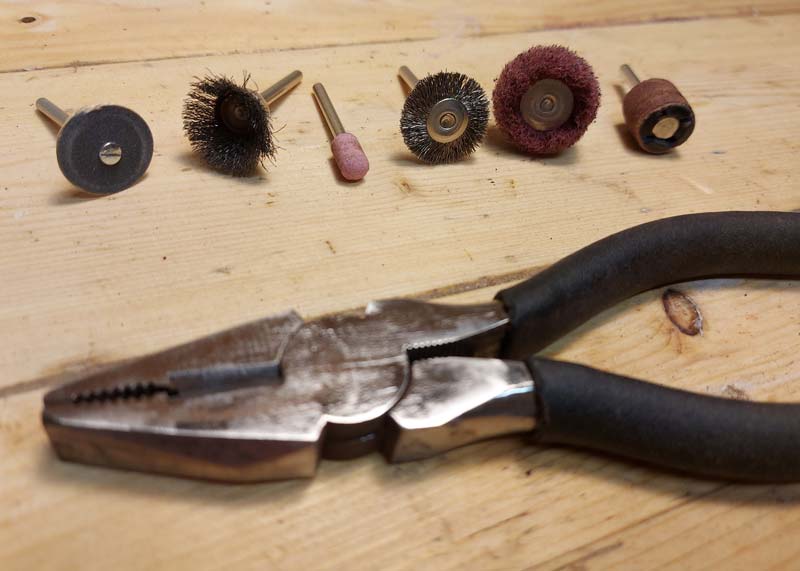Disclosure: This post may contain affiliate links, meaning I get a commission if you decide to make a purchase through my links, at no extra cost to you.
A Dremel is a jack of all trades and a master of some. Removing rust is something the Dremel and rotary tools are really good at. And since Dremel’s are so small, it is especially good at removing rust from hard-to-reach. But it is not the best tool for removing rust from larger surfaces.
To remove rust effectively with a Dremel we can use the sanding drum, a flat sanding disc, an abrasive wheel, grinding bits, or some kind of steel brush. Set the RPM of your Dremel from 20000 to 30000, start the Dremel and start removing rust. Rough sanding bits are the most effective at removing rust quickly.
All the bits listed above are effective at removing rust, but how quickly they remove it and what type of surface they leave will change depending on the bit. We will use the different bits in different types of rust removal and scenarios.

First, I want to give you a very quick intro to what rust is and then go into more detail as to when to use certain bits, and what bits I recommend
What Is Rust? – Quick
Rust is a reaction between water, oxygen, and iron. When iron comes in contact with water and oxygen at the same time a reaction will occur which is called oxidation. This can take days, weeks, or months. The end result is that red-ish coat of rust on your tools and other stuff made from iron.
A little rust is normal and does little harm.
But when you get too much rust, it can seriously harm the structural integrity of the iron, the functionality of your tools and it also looks kind of bad.
Removing rust with your Dremel is a fairly simple process, just put in the right bit in your Dremel and start shaving the rust away with your tool. The hard part is knowing what type of bit is best for the job, and when to use the different bits.
The Best Bits For Removing Rust With A Dremel
Personally, I have removed quite a lot of rust from my hand tools with a Dremel in the past. But to make sure that I could give you the best advice possible in this article, I went down to my shop and tested all the bits below and checked how effective they were at removing rust.
My absolute favorite bit for removing rust effectively is the rough sanding drums.
Daniel, Author Of This Article

I generally use an RPM of between 20000 and 30000 RPMs when removing rust, experiment with what you like the best.
1. Sanding Drum
A rough sanding drum is the most effective bit for removing rust with the Dremel. The sanding drums shave away most of the rust with a single pass, two passes if there is a lot of built-up rust.
I set the Dremel to about 20000 RPMs when using the sanding drums, I feel like I have more control over the tool when compared to higher RPMs. But you can go higher if you feel like it.
The sanding drums have a tendency to “jump” or vibrate when in contact with metal, this will leave an uneven surface. If you want a smooth surface when you are finished removing the rust you have to keep a steady hand, don’t use too much force on the tool, and pass the Dremel in the same direction each time.
To get an even smoother finish you can use the finer sanding drums to remove streaks and groves in the metal.
Sanding drums are also included by default in most bit packages, so you most likely already have some.
Sanding Drums will remove rust quickly, make the metal shine, but it will leave some stripes and streaks in the metal.
2. Steel Brush
Steel brushes are a little bit slower at removing rust but are great to use when you want the metal to have a natural look and do not want the metal to shine too much.
Steel Brushes come in many different shapes. You can for example get steel brushes that are long and thin which is great for removing rust in those crooks and hard-to-reach places. You also get brushes that are flat which are good for covering larger surfaces.
Steel brushes are one of the more versatile bits to use for removing rust. And once you have one secured in your tool, you will find that you probably don’t need anything else.
Especially if you like that rustic look that the metal gets after using the steel brush to remove the rust.
3. Sanding Disc
Sanding discs are great for removing rust. But not only for removing rust, but also for leaving a super smooth and glossy finish to the metal.
I had not tried these sanding discs for removing rust before I tested them for this article. The results I got with them were amazing.
The sanding discs are great for reaching into those tight 90 degree corners, and also removes the rust very effectively.
The fine grit of these sanding discs also removes most of the impurities on the metal surface and leaves a smooth, glossy finish, with next to no streaks or marks in the metal.
4. Grinding Stone
Grinding stones are mainly used for sharpening and to clean up metal and iron edges. So it may be easy to come to the conclusion that the grinding stones are also a good bit for removing rust. But I did not really find the grinding stones effective at removing rust compared to other bits on this list.
The grinding stones removed the rust at a fair rate, but the bit had a tendency to “jump” and vibrate if you tried to remove the rust too quickly. This caused an uneven finish on the metal after the rust was removed and that did not look that good in the end.
The rust also gathered and stuck onto the grinding stone after using it for a while, so you would have to change out the grinding stone fairly often if you choose to use it.
My advice is, save your grinding stones, use them for sharpening and cleaning metal edges. Use something more effective for rust removal.
5. Abrasive Buff
The abrasive buffs were surprisingly effective for removing the thin layer of surface rust and leaving the metal with a natural look.
Now, the abrasive buffs are not too aggressive. So if you have a thick layer of rust on top of the metal, you are going to have a hard time removing it with the abrasive buffs.
But if your tool has started to get some surface rust, and you quickly want to remove it, then the abrasive buffs are perfect to use.
Use a rough (low grit) abrasive buff for removing rust, the finer ones are too soft but can be used for polishing.
Abrasive buffs are also great for reaching some hard-to-reach spots. The soft nature of the buffs makes them fill in the cracks and remove rust wherever they pass.
Safety Gear When Removing Rust
When removing rust with a Dremel we should be using protective gear. Sparks can come flying, bits can fall out of the tool and harmful dust is created.
Eye Protection – For eye protection, we use safety glasses at a minimum, I like to use the ones that also cover the sides of the rims. You can also use a visor that covers your whole face if you want.
Dust Mask – You should at least use an N95 particulate respirator to limit the small rust particle getting into your lungs and body. Be in a well-ventilated area when doing the rust removal.
Gloves – Gloves are generally a good idea to use when working with metal and power tools.
To Summarize
Sanding Drums are the best at removing rust quickly
Steel Brushes are good for hard to reach spots and a natural finish
Sanding Discs leaves the metal shiny, removes rust well, and are good for tight angles
Grinding Stones should not be used unless you do not have anything else
Abrasive Buffs are good for removing surface rust and leaving a natural finish





